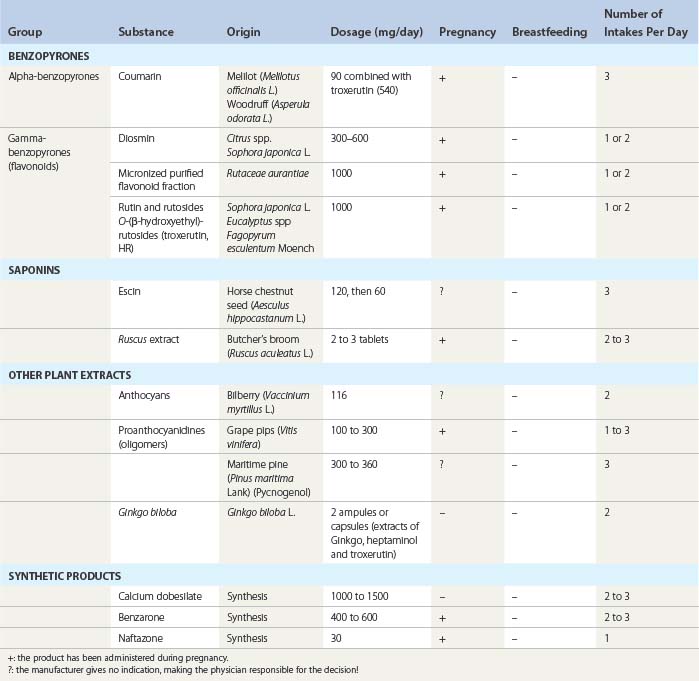CHAPTER 14 Venoactive Drugs
Introduction
Venoactive drugs (VAD) are a heterogeneous group of medicinal products, of plant or synthetic origin, which have effects on edema (C3) and on symptoms related to chronic venous disease (CVD, classes C0s–C6s according to the CEAP classification).1,2 A specific ‘pain-killer’ effect has been suggested, as VAD are active on venous pain, which does not respond to anti-inflammatory drugs.1–5
The main mechanisms of action of VAD are:
Effectiveness of VAD has been regularly discussed, mostly by pharmacologists. Some of them have a poor knowledge of phlebology and VAD; their assertions are debatable. Others are not aware of the difficulty of assessing the activity of VAD.13 Symptoms are subjective, although they can be correctly quantified. Clinical signs such as edema are not easy to measure, owing to significant daily variations in each individual. Efficacy of VAD on edema and venous symptoms may currently be considered as correctly established. However, there is a need for further randomized, controlled clinical trials with greater attention paid to methodological quality.13–15
Classification of VAD
The various classes of VAD are shown in Table 14.1.1–3
In this chapter, we shall distinguish VDA as:
Benzopyrones
This large group of medicines contains many substances, which are often closely related and endowed with multiple pharmacologic properties. Benzopyrones (alpha-pyrones and gamma-pyrones) are obtained from many indigenous and exotic plants, often used in traditional medicine. They belong to the family of phytophenols, and are related to resveratrol, which is currently undergoing a wide range of studies to assess its possible preventative and therapeutic value in atherosclerosis.16
Alpha-benzopyrones
Coumarin induces proteolysis of high-molecular-weight proteins present in lymphedema. Small-size protein fragments can then be more easily drained via the lymphatics. The oncotic pressure drops and edema lessens. However, effectiveness is debatable.17 Although coumarin and its derivatives have an antiedematous effect, they do not modify the coagulation of blood, in contrast to dicoumarols. Alongside its therapeutic properties, the aromatic properties of coumarin are extensively used in spices for cooking, cosmetology (soap, perfumes) and the tobacco industry.
Several cases of drug-related hepatitis have been reported after taking high doses of coumarin or dicoumarols as an anticoagulant. Coumarin has been withdrawn from the market for this reason, except in brands associating low doses of coumarin and troxerutin.18
Gamma-benzopyrones (flavonoids)
Substances mostly used therapeutically in CVD are described below.
Diosmin and Micronized Purified Flavonoid Fraction
Diosmin (3′,5,7-trihydroxy-4′-methoxyflavone-7-rhamnoglucoside) is extracted from plants (rutaceae) or obtained by synthesis (as another bioflavonoid, hidrosmin).19 The half-life of diosmin is 8 to 12 hours, with its elimination being renal (65%) and biliary (35%).
Micronization enables a decrease in particle size of the flavone fraction from 20 to 2 µM (MPFF20–45), thereby increasing the intestinal absorption and bioavailability of the substance, as has been demonstrated in two clinical trials.22–27
MPFF is indicated in the treatment of edema and of symptoms related to venous insufficiency (edema, heavy legs, discomfort, pruritus, night cramps, pain, swelling), pelvic congestion syndrome,42 venous surgery (decrease in postoperative pain and more rapid recovery43,44) as well as lymphedema, including filarial.45 Its other indications are gynecological (tense painful breasts, IUD-related bleeding) and proctological.
All of these effects have been confirmed in double-blind clinical trials,20–44 which also showed a significant improvement in the quality of life of patients suffering from (chronic venous insufficiency) CVI. According to five clinical trials joined in a meta-analysis, MPFF may hasten the healing of leg ulcers.41
Rutosides and Oxerutin
A standard mixture of several flavonoid derivatives is obtained by hydroxyethylation of a natural substance, rutin. Troxerutin is a fraction of oxerutine. Absorbed by the digestive tract, oxerutine has a half-life of 24 hours and is principally excreted in bile. A large number of pharmacological and clinical studies46–58 have provided evidence of its influence on disturbances of capillary permeability, effects on erythrocyte deformation and aggregation, antiedematous actions, and inhibition of prostaglandin synthesis. Its diffusion and accumulation in the venous wall have been demonstrated.54
Saponins
Escin
Escin increases venous wall tone and has a well-demonstrated antiedematous effect.59–64 The HSCE extracts have been evaluated in one Cochrane study, curiously excluding other VADs.12
Ruscus
Extracts of ruscus (butcher’s broom) contain saponins and flavonoids. The precise composition of these extracts is poorly understood. Venotonic and antiedematous actions have been well demonstrated in open and randomized controlled trial (RCT) studies and are associated with a reduction of symptoms in patients suffering from CVD.65–74
Other plant extracts
Extracts of Ginkgo biloba75–78 contain terpens and flavonoids. Antagonists of platelet activating factor (PAF), they have an action on platelet aggregation, blood viscosity, and edema. Extracts of Centella asiatica79,80 are believed to enhance collagen synthesis in connective tissue.
Many other plants are used in the treatment of symptoms of CVD. All of them contain flavonoids among other active substances: procyanidolic oligomers (anthocyans in bilberry extracts; proanthocyanidols in white grape pit, Vitis vinifera,81,82 maritime pine (Pycnogenol)83–85).
Synthetic drugs
Calcium dobesilate
Calcium dobesilate decreases capillary permeability and blood viscosity, and improves lymphatic drainage.86–96 The antiedematous effect persists for about 2 months after treatment is stopped.
Benzarone
Several cases of severe hepatitis have been reported.97 Photosensitization may occur during treatment.
Naftazone
Beta-naphtoquinone monosemicarbazone or naftazone98,99 is rapidly absorbed from the digestive tract. Its half-life is short (1.5 hours) and its metabolites are eliminated in urine.
Principal Mode of Action of VAD
VAD have a demonstrated positive action on:
< div class='tao-gold-member'>
Stay updated, free articles. Join our Telegram channel

Full access? Get Clinical Tree








